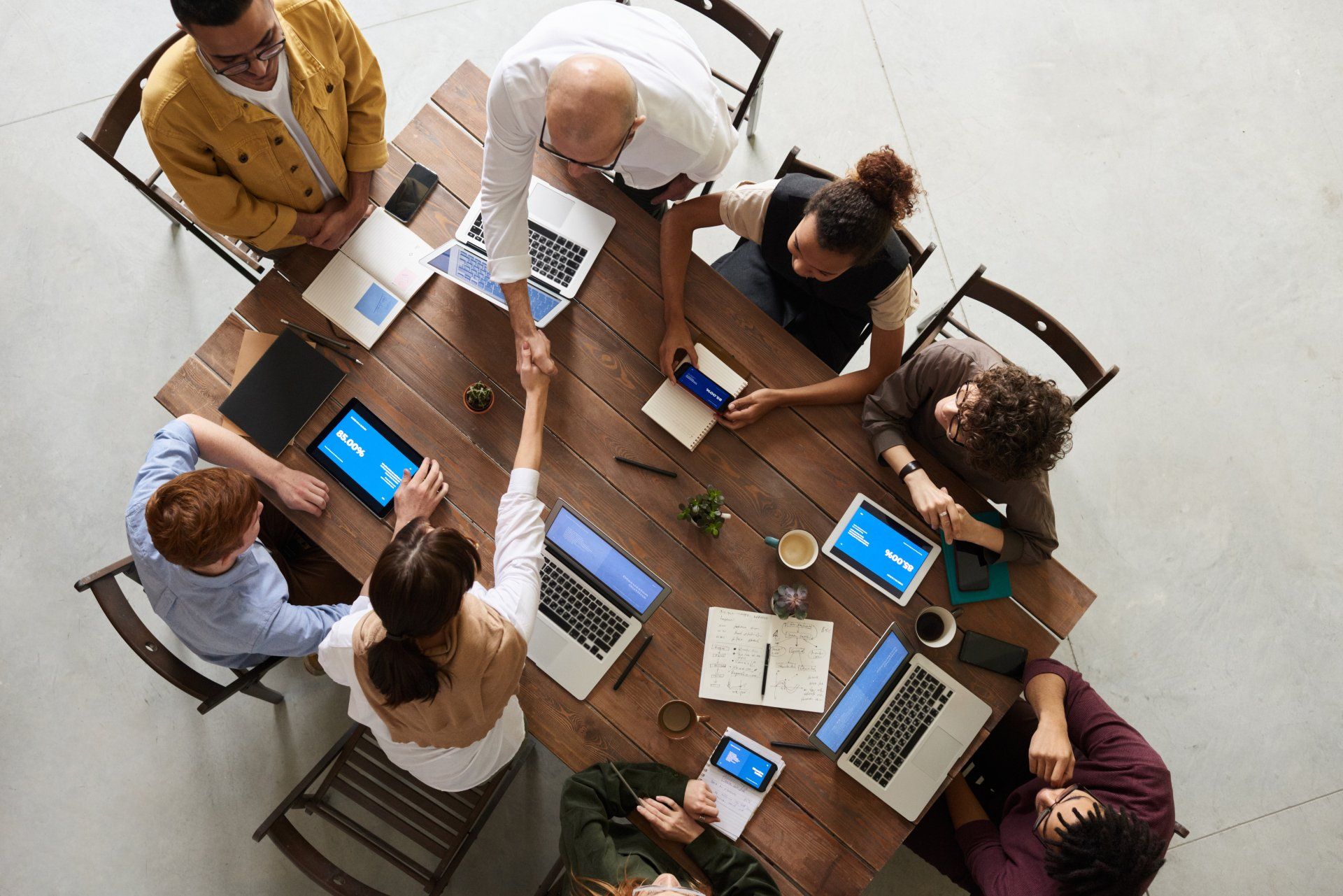Blog

When Leadership Starts to Take Too Much Every CEO knows what burnout feels like — that quiet exhaustion masked by productivity. You keep pushing because that’s what leaders do. But here’s the truth: if you don’t manage your boundaries , your brilliance won’t last. Boundaries aren’t barriers — they’re leadership systems that protect focus, time, and mental health. Why Boundaries Are Strategic, Not Selfish We often mistake saying “no” for being unhelpful or inflexible. But high-performing leaders understand that boundaries are an act of clarity . They communicate what matters most and protect the energy required to lead sustainably. Think of boundaries as your business infrastructure — invisible, but essential for stability. Without them, CEOs become reactive instead of strategic. With them, leaders stay composed, decisive, and clear-minded — the exact qualities that make organizations thrive. The Burnout Cycle CEOs Must Break Here’s how burnout quietly grows: You say yes to everything. You’re spread thin. You lose focus. You feel resentful or drained. This cycle hurts not just your health, but your organization’s health. When leaders are emotionally depleted, decision quality drops, communication becomes tense, and creativity disappears. The FIRM Approach to Setting Boundaries One of the most effective frameworks from the therapeutic world is the FIRM method : F — Frame the boundary clearly: “I’m available for strategy calls on Tuesdays.” I — Identify why it matters: “This helps me stay focused and give you my best.” R — Reinforce with consistency: Boundaries only work if they’re honored. M — Model it for others: When CEOs set boundaries, it gives permission for others to do the same. Boundaries aren’t rigid — they’re reliable. They show your team how to respect limits while still achieving results. How Boundaries Protect Mental Health Boundaries reduce the mental clutter that causes anxiety and fatigue. They create space for recovery and reflection — both vital for high-quality leadership thinking. When CEOs manage time wisely and say no when necessary, they model emotional regulation , the foundation of mental health. A calm leader creates a calm company. Boundaries in Action: Small Changes, Big Shifts Here are small but powerful boundary practices you can start today: Block “thinking time” on your calendar like a client meeting. End meetings five minutes early to reset before the next. Turn off notifications during deep work. Communicate your limits clearly and without apology. Over time, these small acts rebuild your energy and focus — and your team will respect you more, not less. The CEO’s New Role: Leading with Sustainability Leadership is no longer about endurance; it’s about sustainability. Boundaries are what allow CEOs to perform at their best without losing themselves in the process. They transform leadership from survival mode to strategic mastery. When you lead with boundaries, you show your team that clarity and care can coexist. And that’s what defines modern, mentally healthy leadership.

Leadership in the Age of Psychological Safety In today’s corporate world, success isn’t just about strategy. It’s about psychological safety . CEOs are realizing that performance peaks not when people are pushed, but when they feel secure enough to take risks and speak up. But here’s the challenge: how do you build that kind of trust without losing authority ? The answer lies in a powerful yet often misunderstood concept — holding space . What “Holding Space” Really Means for Leaders The term “holding space” comes from therapy, where it means being fully present with someone — without judgment, without trying to fix them, just allowing them to process. In leadership, holding space means creating an environment where employees can bring their ideas, mistakes, and emotions to the table safely. This isn’t about being soft; it’s about being strong enough to stay steady when others can’t. In practice, holding space as a CEO looks like this: Listening without interrupting or rushing to solutions. Asking, “What do you need to move forward?” instead of “Why didn’t you do this?” Allowing others to own their growth and decisions. It’s leadership built on presence, non-judgment, and agency — the three pillars of holding space. Presence: Leadership Beyond Multitasking We live in a world that rewards speed, yet presence requires slowing down. When leaders are distracted — checking emails mid-meeting, glancing at their phones — it signals disinterest and damages trust. But when you are fully present , you send an unmistakable message: “You matter.” Presence is contagious. Teams mirror their leaders. If you lead with calm attention, your organization learns to slow down and focus too — and that’s where creativity and better decisions happen. Non-Judgment: The Language That Builds Safety Many leaders unintentionally erode trust with judgmental language. Questions like “Why did you do that?” or “Who’s responsible for this?” trigger defensiveness. Instead, try curiosity-driven language: “How did you get to that conclusion?” “What’s the context behind this choice?” This small shift reframes conversations from blame to collaboration. Non-judgment doesn’t mean ignoring mistakes — it means addressing them with respect and clarity. Agency: Giving Teams Control Builds Loyalty Micromanagement is often fear disguised as leadership. But in healthy organizations, agency is empowerment . Let people choose how to solve problems, when possible. Set clear outcomes, then step back. Agency turns employees into owners — and owners care more deeply about results. As a CEO, showing trust in your team’s judgment builds the very loyalty and performance most leaders chase through control. Creating a Safe Culture Without Losing Authority Many executives fear that leading with empathy might make them appear weak. The truth is the opposite. When a leader can hold firm boundaries and offer empathy simultaneously, it creates stability and respect. Authority isn’t about domination — it’s about steadiness. Practical ways to build safe yet structured cultures: Clarify expectations early. Safety comes from knowing the rules of engagement. Celebrate learning, not just outcomes. Reward curiosity and reflection. Model accountability. Admit your own mistakes; it sets the tone for honesty. You don’t lose authority when you hold space — you earn deeper trust . The Business ROI of Psychological Safety Google’s Project Aristotle found that psychological safety was the number-one predictor of high-performing teams. When people feel safe, they innovate more, collaborate better, and stay longer. For CEOs, this means: Lower turnover More creative problem-solving Stronger alignment between purpose and performance A safe culture doesn’t weaken business — it strengthens the system from within. Holding space might sound therapeutic, but it’s one of the most strategic leadership tools of our time. When you blend empathy with boundaries, you build an organization that performs because it feels safe to be human. That’s how the best CEOs lead in 2025 — not just with vision, but with emotional intelligence, clarity, and care .

The Shift Every CEO Needs to Make For decades, leadership was defined by performance — numbers, market share, and speed. But in 2025, the most effective CEOs are no longer the loudest voices in the boardroom; they’re the ones who know how to pause. They’ve learned that mental health isn’t a personal issue; it’s a leadership strategy. The modern leader’s competitive advantage is no longer just intelligence or vision, but emotional steadiness. The Hidden Cost of “Always On” Leadership The traditional model of success rewards constant motion — long hours, instant decisions, and endless availability. But neuroscience shows that this style of leadership pushes the brain into what psychologists call “System 1 thinking” — reactive, fast, and emotionally charged. In the short term, it feels productive. In the long run, it leads to burnout, poor decision-making, and a toxic work culture that drains innovation. When CEOs don’t protect their mental health, it doesn’t just affect them personally — it ripples through the entire organization. Stress at the top multiplies downward. Emotional regulation and psychological safety start with the leader. Why Mental Health Is a Leadership Skill Mental health has become a core leadership competency — not a perk or an afterthought. Leaders who prioritize emotional stability lead teams that are calmer, more creative, and more loyal. Why? Because they model regulation instead of reactivity. Here’s what that looks like in action: Presence over panic. Instead of reacting to every crisis, emotionally intelligent CEOs know how to pause, assess, and respond with clarity. Non-judgment over blame. They create psychological safety by replacing “Why did this happen?” with “What can we learn from this?” Agency over control. They empower teams to take ownership, giving them space to think and grow instead of micromanaging. These traits are what therapists call “holding space.” In leadership, that means creating an environment where people feel safe to think, fail, and grow without fear. Holding Space: A CEO’s Superpower Holding space is more than a feel-good phrase. It’s a practice rooted in psychotherapy — the art of being fully present, calm, and non-judgmental, even in discomfort. Applied to business, it becomes a strategic leadership tool . When leaders learn to hold space — for themselves, their team, and the organization — they make better, more sustainable decisions. Here’s how: They stay grounded under pressure. This steadiness prevents emotional contagion, where team stress mirrors the CEO’s stress. They create trust. Teams perform better when they know their leader listens before reacting. They think systemically. By slowing down, leaders can identify patterns in culture and performance — not just symptoms. In short: mental health awareness translates into sharper strategic leadership. From Burnout to Boundaries The first step toward mentally healthy leadership isn’t more meditation apps — it’s boundaries. Boundaries are not walls; they’re structures that protect energy and focus. For CEOs, that can mean: Scheduling “no-meeting” time for deep thinking Logging off email after a certain hour Saying no to projects that don’t align with vision Healthy boundaries are acts of leadership , not weakness. They communicate to your team that rest, clarity, and focus are valued. Creating a Mentally Healthy Organization Leaders set the tone for how the entire organization treats well-being. If you talk about self-care but answer Slack messages at midnight, your team learns that rest isn’t really respected. Here’s what builds a culture of mental wellness that also fuels performance: Normalize reflection. Start team meetings with “What worked this week?” instead of “What went wrong?” Encourage honest dialogue. Invite feedback on how processes or workloads affect stress levels. Train managers in emotional intelligence. EQ can be developed — and it pays off in retention and innovation. When CEOs model calmness and care, they create psychologically safe organizations — and that’s what keeps good people.

CEOs shape organizational resilience through leadership and boundary-setting. By prioritizing mental health, they create cultures that drive retention, productivity, and innovation. This post explores how CEO boundaries lead to tangible business outcomes, supported by data and actionable strategies. The Business Case for Boundaries A 2023 Gallup study found that organizations with high employee engagement—fueled by healthy workplace cultures—see 23% higher profitability and 66% lower turnover. CEOs who set boundaries foster environments where mental health thrives, directly impacting these metrics. Conversely, poor leadership boundaries lead to disengagement, costing companies an average of $450 billion annually in the U.S. alone (Gallup, 2024). How Boundaries Drive Business Success 1. Improved Retention: Clear boundaries, like flexible work policies, reduce employee burnout. Adobe’s 2022 boundary-focused policies cut turnover by 10%. 2. Enhanced Productivity: Teams with mentally healthy leaders are 20% more productive, per a 2023 McKinsey study. 3. Increased Innovation: Psychologically safe environments, fostered by boundary-setting, boost creativity. Google’s 2015 Project Aristotle linked safety to 30% more innovative output. Actionable Steps for CEOs 1. Implement Flexible Policies: Allow hybrid work or no-meeting days to support team mental health. 2. Invest in Resources: Offer mental health programs, like EAPs, to show commitment to well-being. 3. Model Boundaries: Publicly prioritize your own mental health to inspire your team. 4. Measure Impact: Track retention and engagement metrics to quantify the business benefits. CEO leadership in boundary-setting builds resilient organizations by prioritizing mental health. The result? Lower turnover, higher productivity, and a culture of innovation. Start by implementing one boundary-focused policy this month and measure its impact.

The “always-on” culture glorifies constant availability, but for CEOs, it’s a recipe for burnout. This mindset creates mental health challenges that ripple across organizations, undermining leadership and performance. This post uncovers the hidden costs of being always on and offers solutions to protect CEO mental health. The High Cost of ‘Always On’ The World Health Organization estimates burnout costs the global economy $1 trillion annually in lost productivity. For CEOs, the stakes are higher: a 2024 Mind Share Partners study found that 60% of executives reported mental health struggles due to unrelenting work demands. This leads to poor decision-making, reduced creativity, and disengaged teams, as burned-out leaders struggle to inspire. The Ripple Effect on Teams When CEOs neglect boundaries, teams follow suit. A 2023 Gallup study showed that high-stress leadership correlates with 40% higher employee turnover. This not only disrupts operations but also increases recruitment costs, averaging $4,700 per hire (SHRM, 2024). Strategies to Break the ‘Always On’ Cycle Time-Block Your Day: Reserve uninterrupted time for strategic thinking and personal well-being. Set Communication Expectations: Inform your team when you’re unavailable, normalizing downtime. Prioritize Self-Care: Incorporate exercise or mindfulness into your routine. A 2022 Journal of Occupational Health study found that 20 minutes of daily mindfulness reduced executive stress by 30%. Seek Support: Engage a coach or therapist to navigate mental health challenges confidentially. The “always-on” mindset undermines CEO mental health and leadership effectiveness. By prioritizing boundaries and self-care, you protect your well-being and set a powerful example for your team. Take one step today—like scheduling a no-meeting day—to reclaim balance.

CEOs face relentless pressure to be “always on,” but this mindset creates burnout and undermines leadership. Setting boundaries is a powerful way to protect mental health while enhancing team performance. This playbook provides actionable steps for CEOs to establish boundaries, backed by research and tailored for leadership success. The Mental Health Case for Boundaries A 2023 Harvard Business Review study found that 76% of executives report burnout symptoms due to poor work-life boundaries. This not only harms CEOs’ mental health but also cascades to teams, reducing morale and productivity. Boundary-setting is a leadership skill that preserves energy and focus, enabling sustainable success. The Boundary-Setting Playbook Define Your Limits: Identify non-negotiable personal time (e.g., no meetings after 6 PM). Communicate these to your team clearly. Leverage Technology: Use tools like email scheduling or “Do Not Disturb” modes to enforce digital boundaries. Delegate Strategically: Empower your team to handle routine decisions, freeing mental space. A 2021 McKinsey report notes that delegation boosts leader mental health by 25%. Monitor and Adjust: Regularly check in with yourself and your team to ensure boundaries are respected. Adjust as needed to maintain balance. Boundary-setting is a cornerstone of effective CEO leadership and mental health. By defining limits, leveraging tools, and delegating, you model sustainable practices that uplift your team. Start with one boundary this week and track its impact on your well-being.

As a CEO, your leadership sets the tone for your organization’s culture. But are you fostering an environment where employees feel safe to share ideas and concerns? Psychological safety, a critical factor for mental health, is the foundation of high-performing teams. This guide explores how CEOs can model boundaries to create a mentally healthy workplace, backed by research and practical steps. Why Psychological Safety Matters for Mental Health Psychological safety—where employees feel secure to take risks without fear of judgment—directly impacts mental health. A 2015 Google study, Project Aristotle, found that psychological safety was the top predictor of team success, driving innovation and collaboration. For CEOs, fostering this environment starts with intentional leadership. Poor psychological safety leads to stress, disengagement, and higher turnover, costing businesses billions annually, according to Gallup’s 2023 workplace report. How CEOs Can Model Boundaries for Psychological Safety Set Clear Communication Norms: Announce no after-hours emails unless urgent. This signals respect for personal time, reducing employee stress. Lead with Vulnerability: Share your own workload challenges or mental health strategies. A 2022 Deloitte study found that 80% of employees trust leaders who openly discuss mental health. Encourage Feedback: Create anonymous channels for team input, showing that dissent is welcome. Train Managers: Equip leadership teams to recognize burnout and enforce boundaries, reinforcing a culture of care. CEOs who prioritize psychological safety through boundary-setting create workplaces where mental health thrives. By modeling clear boundaries and fostering open communication, you drive innovation and loyalty. Start today by assessing your team’s psychological safety and setting one new boundary.

Effective leadership demands a holistic approach to internal communication, recognizing its multidimensional framework. This system is defined by three distinct flows - Upward, Downward, and Lateral, each serving a specific, vital function that directly impacts productivity and profit. For the CEO, understanding and nurturing the Upward Flow is non-negotiable. Downward: The Direction Flow (Necessary, But Insufficient) Downward communication (from leadership to subordinates) is essential for delegation and distributing information. However, an organization dominated by this top-down approach quickly becomes rigid and unresponsive. True leadership understands that direction must be balanced by receptivity. Upward: The Innovation and Mental Health Flow The Upward Flow is the pulse check of the organization. It's the vital mechanism that allows employees to surface problems, share innovative ideas, and provide crucial feedback. When the CEO and their leadership team actively cultivate and respond to upward communication, two things happen: 1. Innovation: Valuable, ground-level insights are integrated into strategic planning. 2. Mental Health: Employees feel heard, increasing their sense of value and reducing stress, which directly supports their **mental health** and boosts morale. Lateral: The Agility Flow Finally, Lateral communication enables cross-functional collaboration, ensuring departments are aligned on goals. When all three flows are healthy and efficient, the organization operates like a sophisticated nervous system, maximizing its responsiveness and overall vitality. The success of the modern CEO and their leadership team depends on maintaining a strategic balance across all three flows. However, the health and resilience of the entire enterprise hinge on a continuous, valued, and non-negotiable stream of communication flowing up the hierarchy.

The organizational destiny of any modern enterprise is directly tied to the efficiency of its internal communication system. For the modern CEO, building a robust communication framework is not about mandate—it’s about survival in a dynamic market. Formal vs. Informal: The Strategic Balance A key part of the communication blueprint is understanding the interplay between formal and informal channels. Formal communication (reports, official emails) provides structure, clarity, and accountability. However, the social fabric of the organization, the trust and agility required for quick problem-solving is built through informal communication. The CEO must ensure leadership fosters a strategic balance, preventing an over-reliance on rigid, top-down structures that stifle valuable feedback. Lateral Communication and Innovation Organizational agility relies heavily on Lateral/Horizontal Communication—the flow of information between peers and across departments. When silos exist, innovation dies. Effective leadership must facilitate this cross-functional collaboration to ensure knowledge sharing and joint problem-solving. This efficient flow is crucial for driving productivity and ensuring the organization can respond quickly to market shifts. The CEO’s Human-Centric Mandate The path to a thriving workforce begins with an unwavering commitment to communication excellence, which requires specific skills from the CEO and the leadership team. This includes active listening, strategic channel selection, and maintaining radical transparency. This culture, which also supports employee mental health, positions the organization as a responsive, unified entity ready to meet market demands. The CEO acts as the architect of the communication ecosystem. By strategically balancing formality, facilitating lateral flow, and practicing transparent leadership, the organization gains the agility and resilience needed for sustainable growth.
